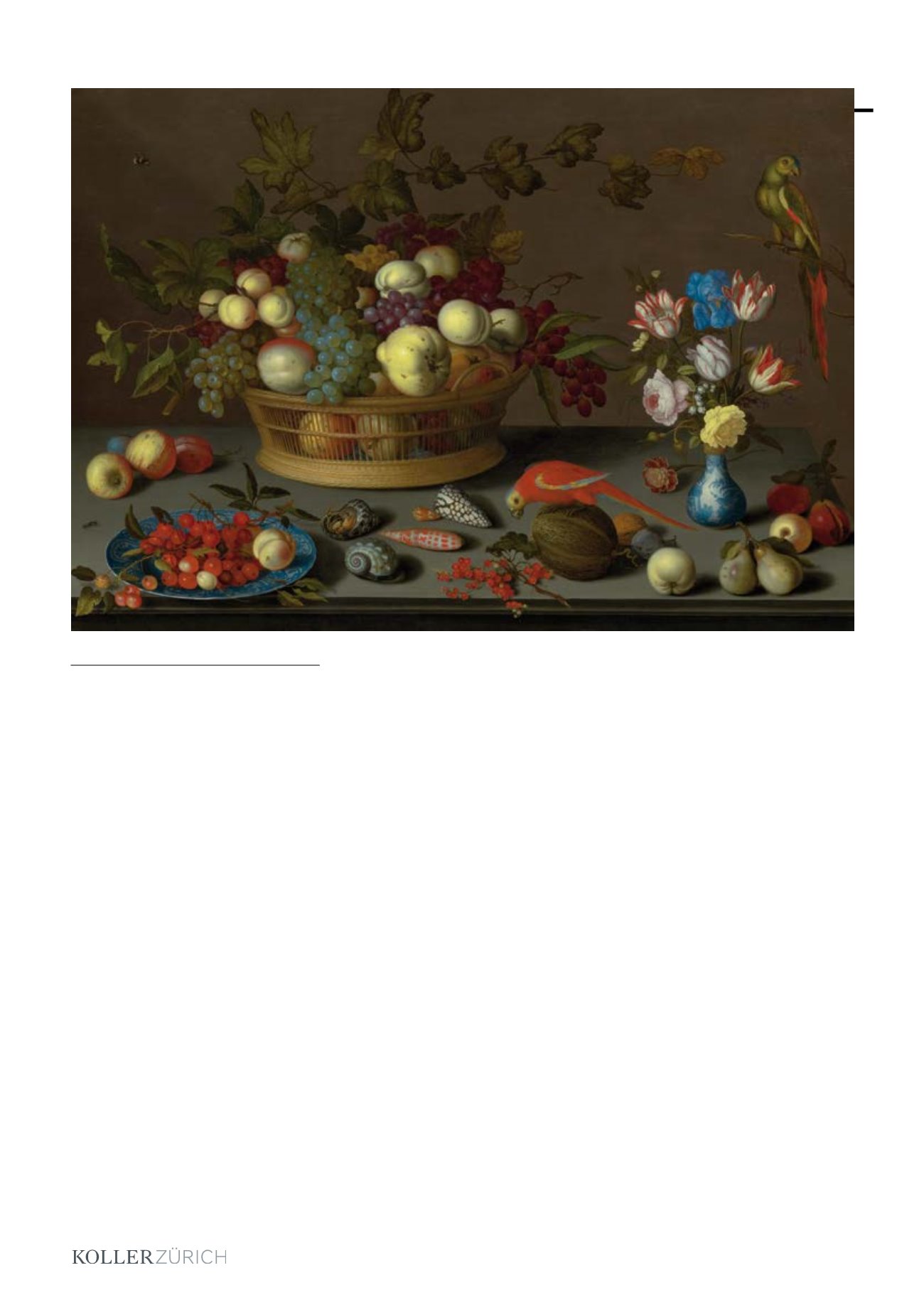
 3040*
AST, BALTHASAR VAN DER
3040*
AST, BALTHASAR VAN DER
(Middelburg circa 1593 - 1657 Delft)
Large still life with fruit on a Delft plate, seas-
hells, insects, flowers in a Wanli vase and two
parrots. Circa 1620.
Oil on panel.
Signed lower centre: .B.vander.ast..
77 x 107 cm.
Provenance:
- Reverend J. Willemsen collection, Middel-
burg, 1780.
- Kalbfleisch collection, Flushing, NY.
- S. Westerman collection, Amsterdam, 1935.
- I. Heitmanek-Engeling collection, Zurich.
- Eugene Slatter, London.
- Alexander Leger Galleries, London, 1977.
- Gebr. Douwes, Amsterdam/London.
- Private collection, USA, since 1979.
Literature:
- Die Weltkunst, IX, no. 28/29 and X, no. 50.
- Nieuwe Rotterdamse Courant, 29.6.1935.
- De Zakenwereld, Amsterdam 1935, no. 14.
- Apollo Magazine, May 1955, vol. 61, p. 132.
- Connoisseur, May 1955, vol. 133, p. XVIII.
- Bol, L. J.: The Bosschaert Dynasty, Leigh-on-
Sea 1980, no. 117, p. 85-86.
- Briels, J.: Vlaamse schilders en de dageraad
van Hollands Gouden Eeuw, 1585-1630, Ant-
werp 1997, no. 417, p. 260.
Exhibited:
- Bloemstukken, Kunsthandel P. de Boer,
Amsterdam 1935, no. 7.
- Dutch and Flemish Masters, Eugene Slatter,
London, April - July 1955, no. 13.
This still life by Balthasar van der Ast, because
of its quality as well as its large size, is a master-
piece of Dutch painting of the 17th century. The
extraordinary variety of objects depicted in the
finest detail, including fruit, flowers, seashells,
ceramics, insects and exotic birds, demonstrate
the artist’s ability to create a still life from each
individual object. A work like this would in fact
have served as a showcase for the artist’s wide
range of talents, so that a prospective client
could use it as a source of possible elements for
the painting he requested. That this represen-
tative and large work should have traversed
four centuries and remained in such impeccable
condition classes it amongst the highest rarities.
Balthasar Van der Ast is one of the most
important Dutch still life painters of the 17th
century. His contribution to this genre consists
of approximately 200 large and small format
paintings, characterised by their finesse and
subtlety. The present work is a typical example
from his Utrecht period, where settled in 1619,
and during which time he began to distance
himself stylistically from his brother-in-law
and teacher, Ambrosius Bosschaert the Elder
(1573-1621). Utrecht at the time must have been
a highly stimulating environment for the young
Van der Ast. Not only had Roelandt Savery
(circa 1576-1639) settled here upon his return
from Prague, but soon Bosschaert the Elder’s
three sons, Ambrosius the Younger (1609-1645),
Johannes (1608-1629) and Abraham (1612-1643)
would move from Middelburg to Utrecht, ma-
king the city a new centre for still life painting
from 1620 on.
The pervading motifs in the present work are
a direct result of the widespread fascination
in Holland at this time for the Exotic, kindled
by the Dutch East India Company’s newly
developed trade routes to the Asian continent.
Some examples of this are the seashells depicted
here: from left to right, a West Indian „cittari-
um pica“ with a hermit crab, an orange-flecked
„mitra mitra“, a small golden „conus aurantius“
and a „marbled cone shell“, one of Van der
Ast’s signature elements and highly prized by
Dutch collectors. The two parrots, which were
considered curiosities in the 17th century and
possessed only by wealthy families, also add an
exotic and luxurious element to the compositi-
on, as does the Wanli porcelain vase to the right
of the painting. Similar vases can be found in
approximately fifteen small-format still lifes by
Van der Ast from the 1620s, none of which can
be traced to a specific prototype, as the artist
constantly varied the vases’ decoration.
The floral arrangement in the present work is
comparable with the somewhat later compo-
sition “Flowers in a vase with seashells and
insects”, in the National Gallery, London (inv.
no. NG6593, oil on panel, circa 1630, 47 x 36.8
cm). This motif was apparently inspired by the
numerous floral bouquets in Wanli vases painted
by Van der Ast’s master, Ambrosius Bosschaert
the Elder, for example a composition from 1619
in the Rijksmuseum, Amsterdam (inv. no. SK-
A-1522, oil on copper, 31 x 22.5 cm). In contrast
to the work of Bosschaert, more concerned
with an artistic rendering of nature, Van der Ast
endowed a feeling of elegance and intimacy to
his paintings, expressed in the work offered here
in an exemplary manner.
CHF 850 000 / 1 200 000
(€ 798 330 / 1 111 110)
3040
| 53
















